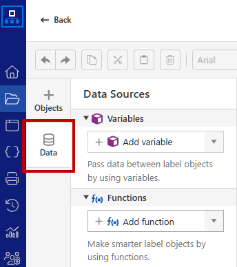Prompt variables
Prompt variables apply values you enter manually before printing. You type your variable values in your print form.
To create a new prompt variable:
Click the
Data icon to open theData Sources menu.
Expand the
Variables drop-down menu, then clickAdd variable .In the drop-down menu, click
New Variable .The variable properties window opens, where you can define your variable name, type, initial value, and other properties. Web Designer supports the following
Data types :Text : Web Designer supports all characters, including special characters. You can also copy text from other resources like the internet or text editors.Time : Manually enter a time value in the predefinedInput format you define in theInput Rules section. Printed value will haveOutput format defined inOutput rules . With this type of variable, you select fixed time. If you want to print the current time (with or without time offset, use theCurrent time variable.You can select a predefined
Input format andOutput format or type your formats.Date : Manually enter a date value in the predefinedInput format you define in theInput Rules section. Printed value will haveOutput format defined inOutput rules . With this type of variable, you select a fixed date. If you want to print the current date (with or without time offset, use theCurrent date variable.You can select a predefined
Input format andOutput format or type your formats.Floating point : Variable that represents real numbers. Decimal values are usually separated by "." or "," for example: 8,972.33Currency : transforms your numeric inputs into currency values that consist of a currency symbol and a number. Values can have up to two decimal places.Example
Your variable value is 1270.
Your currency is USD.
In
Input rules , you define 0 decimal places. InOutput rules , you define 2 decimal places, setSeparator to "," andCurrency symbol to "$".Web Designer prints $ 1,270.00.
Set the variable properties. Different types of variables have different properties:
Set the
Initial value . This is your default variable value that is set when you start your print form. The initial value helps you understand the purpose of the variables and the syntax of the variable values. For example, your variable name isCoutry_of_origin, and the initial value is GER. To enter special characters into the initial value, click the icon right to theInitial value edit field.Provisional value is a value you use when you design your label. For example, you would like to define the maximum size of your Text object on the final print. You use the longest expected value (string) as aProvisional value to make sure your printed text is not out of your label.The
Auto-generate option copies the value from theInitial value to theProvisional value .
In the
Prompting section:You can lock the variable value and use only the
Initial value at printing time if you disable the optionPrompt for the value at print time .You can change your default prompt text from a variable name to some more describing text. For example, your variable name is
prod_var, and to avoid confusion, you want to change the prompt to "Enter the product code."Value can not be empty at print time means that your label won't print, and an error message will pop up if you don't enter some variable value.
You can define
Input rules for your variables:Allowed characters : You can limit input characters to numeric, alphanumeric, letters, or other.You can
Limit your input string length or define theFixed length of your variable value.With the
Check range option, you can define minimum, maximum, or both values for your variable inputs. For example, you would like to limit your product code inputs from 701 to 800.With
Pick list, you can predefine your list of variable values. ThePick list acts as a simple database linked to your variable. If you enable thePick list option, you can print only the values defined in the Pick list values edit field.
You can modify your input variable values with
Output rules .You can add a
Prefix orSuffix to your input value. For example, your input value is "John Doe." You would like to print the string "Name: John Doe," so you add a prefix "Name: ".To print fixed-length texts or numbers, even if your variable inputs are variable length, use the
Pad character option. To enable thePad character option, first define theLimit option in Input rules. For example, your variable enables numeric values from 1 to 9999. You would always like to print all four characters, for example, "0027" instead of "27:"In
Input rules , set theLimit option to "4".Set the
Pad character option toOn left .Set the
Character option to "0".
Your variable value will print as "0027".
The
Multiline option enables you to design a multiline text variable. Without this option, long texts will print in a single line and may exceed the label area. You can define theNumber of lines ,Line length (in number of characters) andEnable word wrap .
To use prompt variables with your label objects:
Place the label object on the design surface.
Click the object to open the object properties.
In the
Source section, select your prompt variable.
Your label object now presents the prompt variable value.